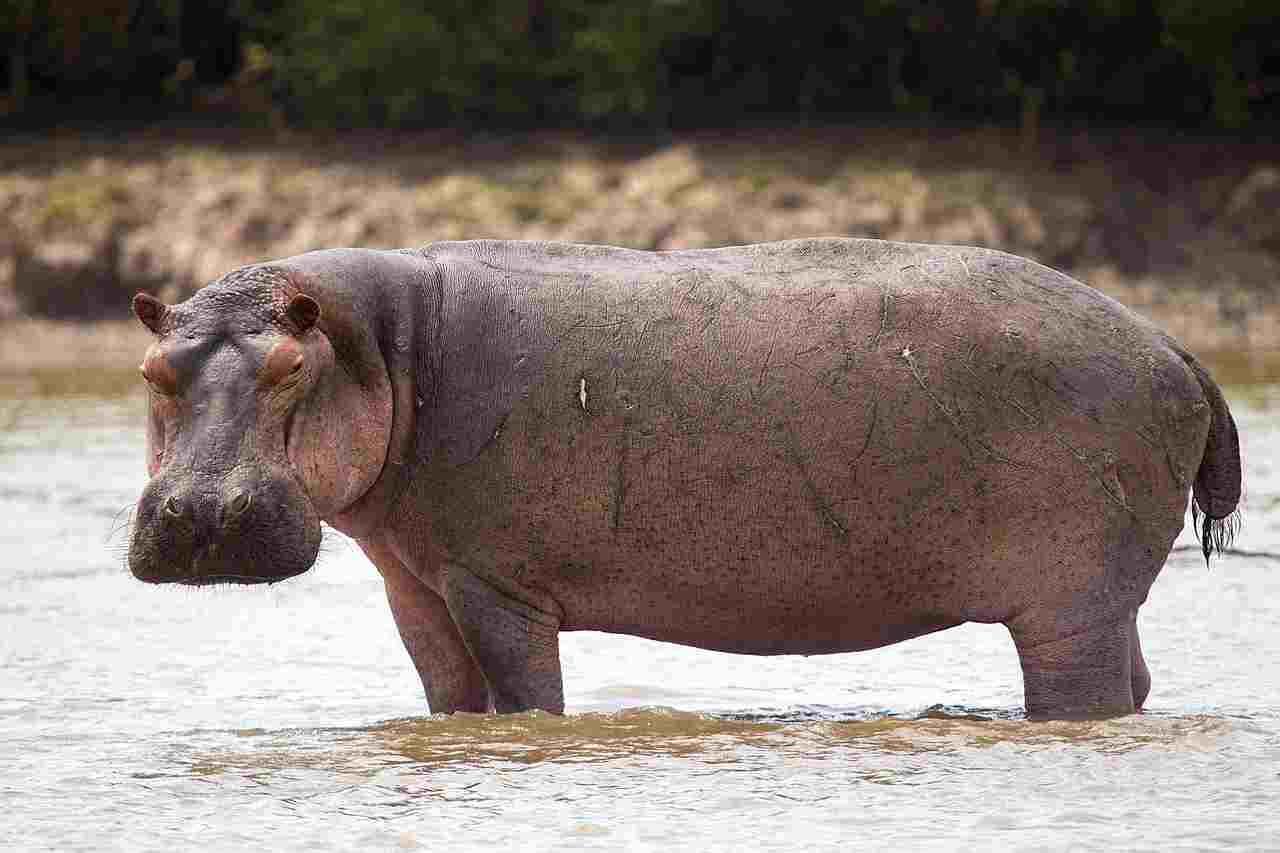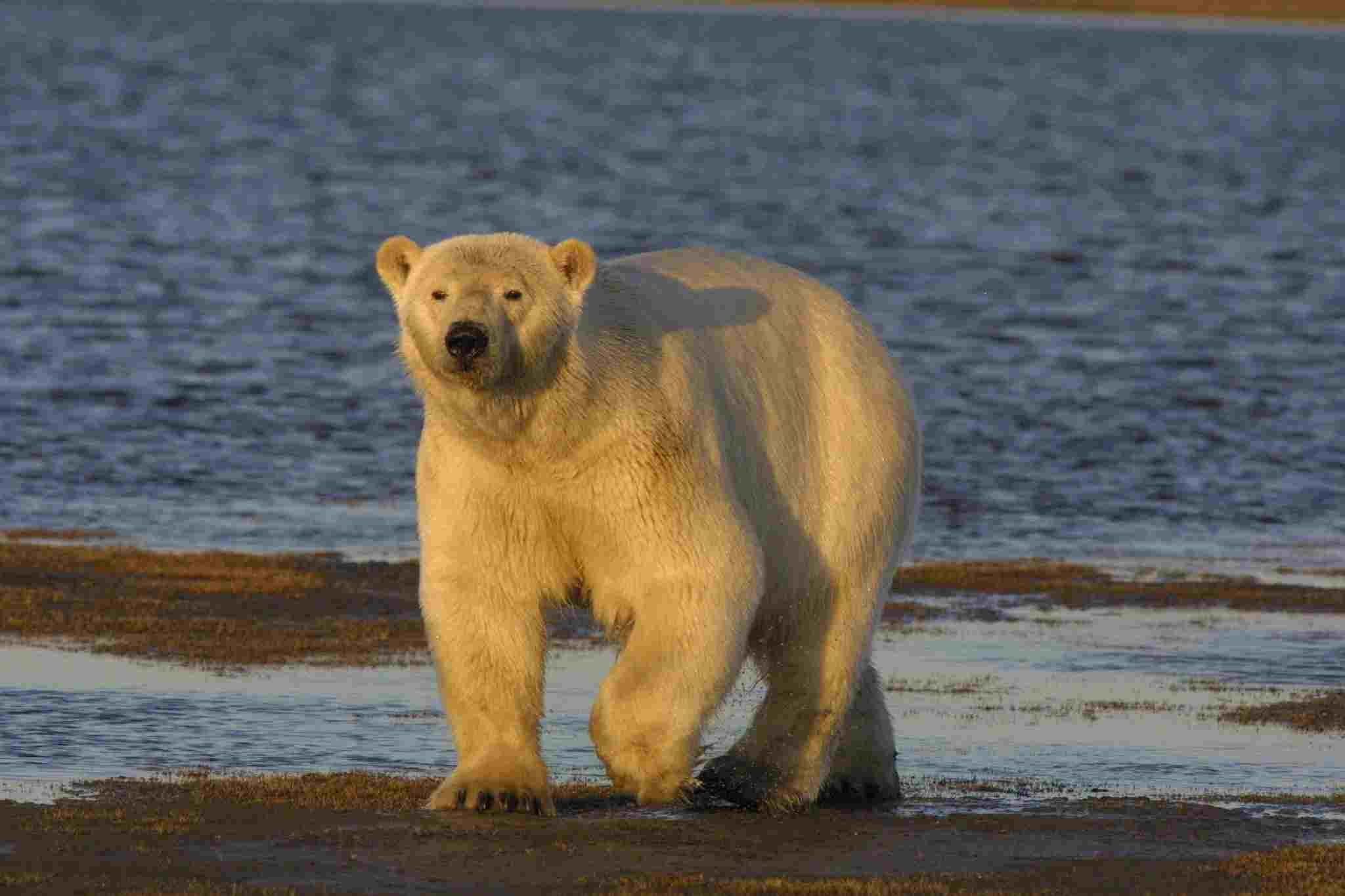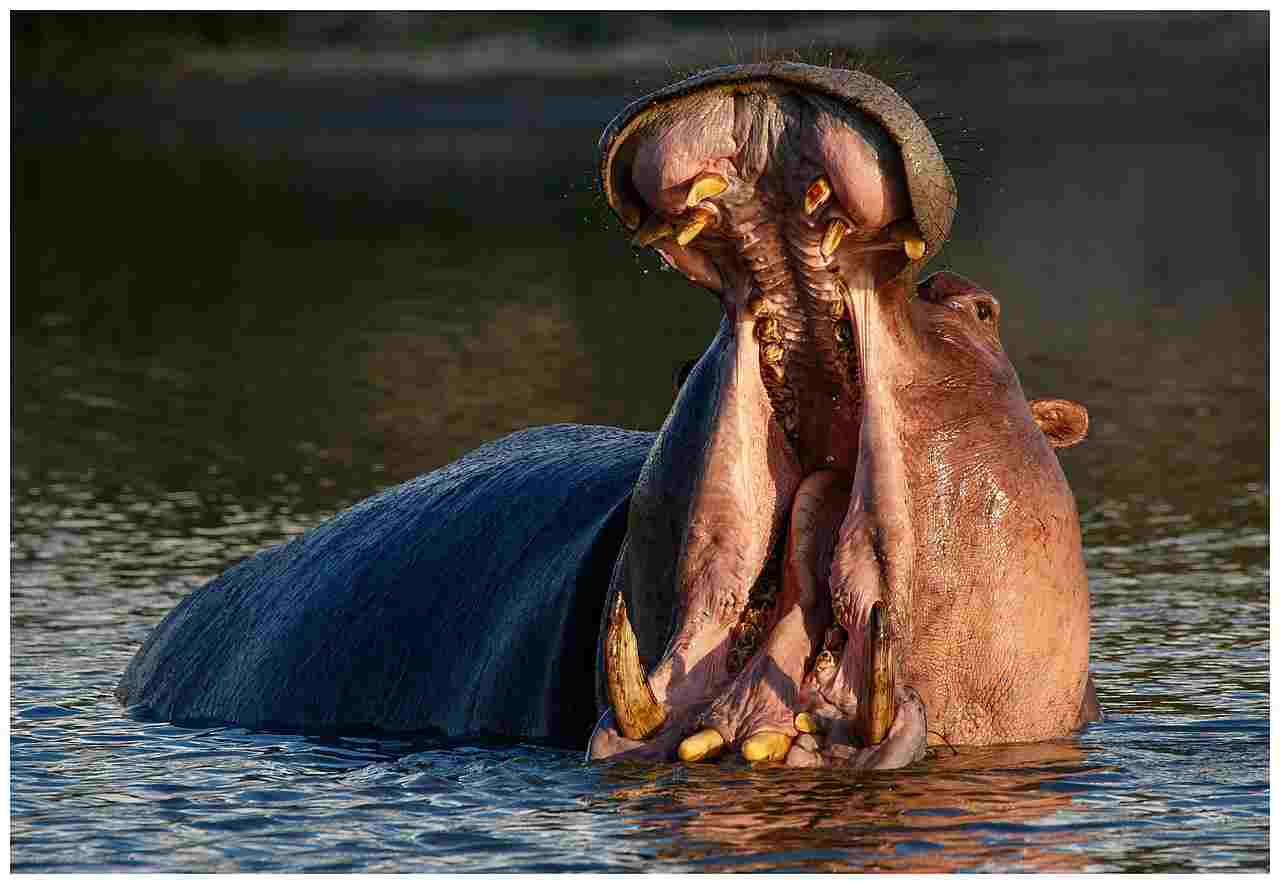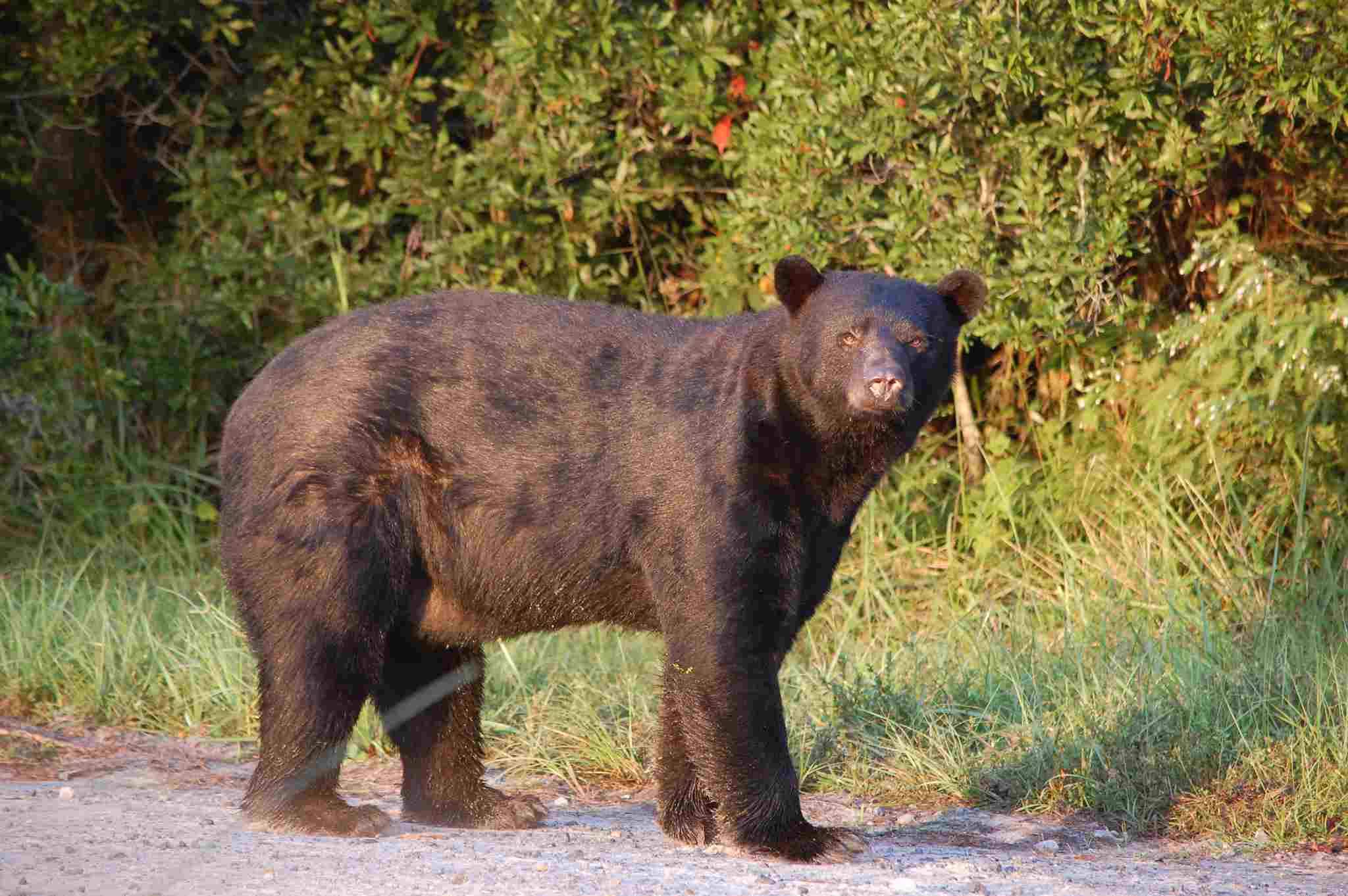Bear Vs Hippo Comparison by Size, Weight, Ecological Impact
Bear and hippo can be compared to each other based on factors like size, weight, and ecological impact. These comparisons can provide insights into their physical characteristics, behavior, and ecological roles.
By examining their similarities and differences, we can better understand the potential outcomes of interactions between these two animals.
Key Outcomes of Comparison
A) Size:
When comparing the size of bears and hippos, it is evident that hippos are larger. Hippos can reach lengths of up to 16 feet and weigh between 3,000 to 4,000 pounds, while bears vary in size depending on the species, with the largest, the polar bear, reaching lengths of up to 10 feet and weighing around 1,500 pounds.
B) Weight:
As mentioned earlier, hippos are significantly heavier than bears. Their massive bodies and dense bones contribute to their weight, making them one of the heaviest land mammals. In contrast, bears, although still formidable in size, are comparatively lighter.
C) Taxonomic Classification:
Bears and hippos belong to different taxonomic families. Bears are part of the Ursidae family, while hippos are part of the Hippopotamidae family. This distinction reflects their evolutionary history and genetic relationships.
D) Hypothetical Interaction:
In a hypothetical confrontation between a bear and a hippo, the hippo would likely emerge as the victor. With its massive size, powerful jaws, and aggressive nature, the hippo possesses the advantage in terms of strength and defense mechanisms. However, it is important to note that such interactions are rare in the wild, as bears and hippos inhabit different ecosystems and have distinct behaviors.
*Physical Comparison
1). Size
When comparing the size of bears and hippos, we need to consider their average height and total body length. Hippos are known for their massive size, with males reaching heights of up to 5 feet and lengths of around 13 feet. On the other hand, bears vary in size depending on the species. Grizzly bears, for example, can grow up to 8 feet tall and have a length of about 7 feet.
In terms of which is larger, it is clear that hippos take the lead. Their robust bodies and large heads contribute to their impressive size. Bears, while still formidable in their own right, are generally smaller in comparison.
It’s important to note that these measurements can vary among individuals and species. Additionally, the size of bears and hippos can also differ between males and females. For a more accurate comparison, it is necessary to consider the average size of both genders.
2). Weight
When comparing the weight of bears and hippos, it is important to consider the average weight of both males and females. Hippos are known for their immense size and weight, with males weighing around 3,300 to 4,000 kilograms (7,300 to 8,800 pounds) and females weighing slightly less. On the other hand, bears vary in weight depending on the species. Grizzly bears, for example, can weigh anywhere from 180 to 360 kilograms (400 to 800 pounds).
In terms of which is heavier, hippos clearly take the lead. Their massive bodies and dense bones contribute to their substantial weight. Bears, while still formidable in their own right, are generally lighter in comparison.
It’s important to note that these weight ranges can vary among individuals and species. Additionally, the weight of bears and hippos can also differ between males and females. For a more accurate comparison, it is necessary to consider the average weight of both genders.
3). Skeletal Anatomy
The skeletal anatomy of bears and hippos reveals significant differences in their skeletal structure and bone density. Hippos have a unique skeletal structure that is adapted for their semi-aquatic lifestyle. Their bones are dense and heavy, providing them with buoyancy and stability in water. In contrast, bears have a more versatile skeletal structure that allows them to adapt to various habitats and modes of locomotion.
Hippos have large, thick bones that support their massive bodies and help them navigate through water. Their limbs are short and stout, with strong joints and muscles that enable them to move efficiently in aquatic environments. Bears, on the other hand, have longer limbs and more flexible joints, which allow them to run, climb, and swim with ease.
In terms of bone density, hippos have exceptionally dense bones, which contribute to their overall weight. This density helps them stay submerged in water and provides protection against predators. Bears, although not as dense as hippos, still have strong and sturdy bones that support their muscular bodies.
These differences in skeletal anatomy between bears and hippos reflect their distinct evolutionary adaptations and ecological niches. While hippos have evolved to thrive in water, bears have adapted to a wide range of habitats and locomotion modes.

4). Mode of Locomotion
Bears and hippos have distinct modes of locomotion that are adapted to their respective habitats and ecological needs.
Bears are known for their versatility in movement. They have the ability to run, climb, swim, and even leap. Their strong and flexible limbs, along with their muscular bodies, allow them to navigate various terrains with ease. Bears are agile climbers, using their sharp claws and powerful limbs to ascend trees and rocky surfaces. When it comes to swimming, bears are proficient swimmers, using their large paws to paddle through water effortlessly. Their ability to run at impressive speeds enables them to chase down prey or escape from potential threats.
On the other hand, hippos are primarily adapted for a semi-aquatic lifestyle. They are excellent swimmers, using their powerful limbs and webbed feet to propel themselves through water. Hippos can move gracefully in water, reaching speeds of up to 8 miles per hour. However, on land, their movement is more cumbersome. Hippos have short legs and a bulky body, making them slow runners and climbers. They rely on their massive size and strength to intimidate predators rather than relying on speed or agility.
5). Speed
When comparing the speed of bears and hippos, it is important to consider their respective habitats and adaptations.
Bears are known for their impressive speed, especially considering their size. The average speed of a bear can vary depending on the species, but they are capable of reaching speeds of up to 30 miles per hour (48 kilometers per hour) in short bursts. This speed allows them to chase down prey or escape from potential threats. Bears are agile runners, utilizing their powerful limbs and muscular bodies to move swiftly across various terrains.
On the other hand, hippos are not known for their speed on land. Due to their bulky bodies and short legs, hippos are relatively slow runners. They can reach speeds of around 19 miles per hour (30 kilometers per hour) on land, but they are not built for sustained speed or agility. However, in water, hippos are incredibly fast and graceful swimmers. They can reach speeds of up to 8 miles per hour (13 kilometers per hour) in water, using their powerful limbs and webbed feet to propel themselves.
6). Agility
When comparing the agility of bears and hippos, we need to consider their speed and mode of locomotion. Agility refers to the ability to move quickly and easily, change direction, and navigate through different terrains.
In terms of speed, bears are surprisingly agile for their size. With their powerful limbs and muscular bodies, they can reach speeds of up to 30 miles per hour (48 kilometers per hour) in short bursts. This allows them to swiftly chase down prey or escape from potential threats. Bears demonstrate remarkable agility when navigating through various terrains, including forests, mountains, and even snow-covered landscapes.
On the other hand, hippos are not known for their agility on land. Due to their bulky bodies and short legs, they are relatively slow runners. However, in water, hippos display incredible agility. With their powerful limbs and webbed feet, they can reach speeds of up to 8 miles per hour (13 kilometers per hour) in water. Hippos are graceful swimmers, effortlessly maneuvering through rivers and lakes.
7). Relative Strength and Endurance
When comparing the relative strength and endurance of bears and hippos, several factors need to be considered, including muscular endurance, size, weight, and agility.
In terms of muscular endurance, hippos have the advantage. Due to their superior weight and size, hippos possess immense strength that allows them to exert force for extended periods. This strength is particularly evident in their ability to defend themselves and their territories against potential threats. Hippos can use their powerful jaws and massive bodies to overpower adversaries, making them formidable opponents in confrontations.
On the other hand, bears exhibit impressive strength and endurance considering their size. Despite being smaller than hippos, bears compensate with their muscular bodies and remarkable agility. This enables them to engage in activities that require strength and endurance, such as hunting and foraging for food. Bears are known for their ability to take down large prey and endure physically demanding tasks, showcasing their relative strength and endurance.
8). Bite force
When comparing the bite force of bears and hippos, it is important to consider their average bite force in pounds per square inch (psi). The bite force of an animal is a crucial factor in determining its ability to capture and consume prey, as well as defend itself against potential threats.
Hippos are known to possess an incredibly powerful bite force. With their massive jaws and strong teeth, they can exert a tremendous amount of pressure. The average bite force of a hippo is estimated to be around 1,800 psi, making it one of the strongest bites in the animal kingdom. This immense bite force allows hippos to crush bones and tear through tough vegetation with ease.
On the other hand, bears also have a formidable bite force. While not as high as that of hippos, bears still possess a significant amount of biting power. The average bite force of a bear ranges from 600 to 1,200 psi, depending on the species. This bite force enables bears to effectively capture and subdue their prey, which can include large mammals like deer and elk.
Therefore, while hippos have a higher average bite force compared to bears, both animals possess impressive biting capabilities that are essential for their survival and hunting strategies.
9). Attack and Defense Method(s)
When it comes to attack and defense methods, both bears and hippos have unique strategies that they rely on for survival.
Bears primarily use their physical strength and sharp claws as their main weapons for both offense and defense. With their powerful forelimbs and long, curved claws, bears can deliver devastating blows to their opponents. These claws are not only used for hunting and capturing prey but also for defending themselves against potential threats. Bears are known to stand on their hind legs and swipe at their adversaries with their formidable claws, inflicting serious injuries.
On the other hand, hippos have a different approach to attack and defense. Despite their seemingly docile appearance, hippos are actually highly aggressive and territorial animals. They rely on their massive size and weight as their primary defense mechanism. When threatened, hippos can become extremely aggressive and charge at their opponents with incredible speed. With their powerful jaws and sharp teeth, they can deliver crushing bites that can cause severe damage.
Comparing the efficiency of their attack and defense methods, it is difficult to determine which is more effective. Bears’ strength and claws provide them with a formidable advantage, while hippos’ size and aggression make them a force to be reckoned with. Ultimately, the effectiveness of their attack and defense methods depends on the specific circumstances and the nature of the threat they face.
*Hypothetical Interaction
In a hypothetical interaction between a bear and a hippo, it is difficult to determine the outcome. Both animals possess unique physical attributes that could give them an advantage in a fight. The hippo, being larger and heavier, has a significant size advantage over the bear. Its massive size and weight make it a formidable opponent, capable of delivering crushing blows with its powerful jaws and sharp teeth. On the other hand, the bear’s strength and sharp claws provide it with a formidable offense and defense.
In terms of aggression, both animals have the potential to be highly aggressive when threatened. The hippo’s territorial nature and tendency to charge at opponents with incredible speed can be a significant threat. However, the bear’s ability to stand on its hind legs and swipe at adversaries with its formidable claws cannot be underestimated.
*Behavioral Comparison
10). Feeding/Predation Habits
Feeding habits play a crucial role in understanding the ecological impact of bears and hippos. Both species have distinct dietary preferences and feeding behaviors.
Bears are known to be omnivores, meaning they consume both plant matter and animal protein. Their diet varies depending on the species and their habitat. Some bears, like the polar bear, primarily feed on seals and other marine mammals, while others, like the black bear, have a more diverse diet that includes berries, nuts, insects, and small mammals. Bears are opportunistic predators and scavengers, using their sharp claws and powerful jaws to catch and consume their prey.
On the other hand, hippos are herbivores, feeding mainly on grasses and aquatic plants. They are bulk grazers, consuming large quantities of vegetation to meet their nutritional needs. Hippos have a unique feeding behavior where they graze on land during the night and spend most of the day submerged in water to keep cool. They use their large jaws and sharp incisors to tear and chew vegetation.
The contrasting feeding habits of bears and hippos highlight their different ecological roles. Bears, as omnivores, have a wider range of food sources and can adapt to various environments. Their predation and scavenging behaviors also contribute to the nutrient cycling in ecosystems. Hippos, as herbivores, have a significant impact on the vegetation in their habitats, shaping the structure and composition of plant communities.
11). Social Behavior
Bears and hippos exhibit contrasting social behaviors. While bears are generally solitary animals, hippos are highly social creatures.
Bears, depending on the species, tend to be solitary animals, with individuals typically living and foraging alone. They have large home ranges and are known to be territorial, marking their territories with scent markings and vocalizations. However, there are exceptions to this rule, as some bear species, like the brown bear, may exhibit more social behavior during certain times, such as during the salmon spawning season when they gather in large numbers to feed.
On the other hand, hippos are highly social animals, living in groups called pods or bloats. These groups can consist of several individuals, ranging from a few to over a hundred members. Within these groups, there is a complex social structure, with dominant males leading and defending their territories. Hippos communicate with each other through various vocalizations and body postures, which help maintain social cohesion and resolve conflicts.
The social behavior of hippos is not limited to their own species. They often interact with other animals, such as birds and fish, that coexist in their aquatic habitats. These interactions can be mutually beneficial, as the birds feed on parasites and insects on the hippos’ skin, while the hippos provide protection and a source of food for the birds.
12). Aggressive Tendency
When comparing the aggressive tendencies of bears and hippos, it is important to consider the conditions that can cause aggression in these animals. Both bears and hippos have the potential to exhibit aggressive behavior, but the triggers and intensity of aggression may vary.
For bears, aggression can be influenced by factors such as competition for food or mates, defending their territory, or protecting their young. In certain situations, bears may display defensive aggression if they feel threatened or cornered. It is important to note that not all bear species have the same level of aggression, with some being more prone to aggression than others.
Similarly, hippos can also exhibit aggressive behavior, especially when they feel their territory or offspring are being threatened. Male hippos, in particular, can become highly aggressive during the mating season when they compete for dominance and access to females. They may engage in territorial disputes, charging, and even fighting with other males.
It is crucial to understand that aggression in both bears and hippos is typically a response to specific stimuli or perceived threats.
13). Danger to Humans (and Pets)
When considering the danger posed by bears and hippos to humans and pets, it is important to assess their potential for harm, including the likelihood of attacks and the severity of injuries.
Bears, although generally shy and avoiding human contact, can become dangerous if they feel threatened or if their cubs are in danger. While attacks on humans are rare, they can occur, especially when humans unknowingly approach a bear or invade its territory. In such cases, bears may exhibit defensive aggression, resulting in injuries or even fatalities. However, it is important to note that bears do not typically view humans as prey and are more likely to avoid confrontation if given the opportunity.
On the other hand, hippos are known to be one of the most dangerous animals in Africa. Despite their herbivorous diet, hippos are responsible for numerous human fatalities each year. Their territorial nature and aggressive behavior, particularly during the mating season, make them a significant threat. Hippos can charge at high speeds, trample or bite, causing severe injuries or death.

13a). Likelihood of Interaction (With Humans)
The likelihood of interaction between bears and humans depends on the proximity of bear habitats to human settlements. Bears are known to inhabit various regions, including forests, mountains, and even suburban areas. However, the frequency of bear sightings near human settlements can vary depending on factors such as food availability and habitat destruction.
In areas where bears have easy access to human food sources, such as garbage cans or improperly stored food, the likelihood of interaction increases. Additionally, if humans encroach upon bear habitats or engage in activities that attract bears, such as hiking or camping, the chances of encountering a bear are higher. It is important for humans to be aware of bear habitats and take necessary precautions to minimize the likelihood of negative interactions, such as securing food and waste properly and avoiding direct contact with bears.
13b). Precautionary Measure(s)
If you encounter a bear, it is important to know how to react to ensure your safety and minimize the risk of a negative interaction. The first and most crucial step is to remain calm and avoid any sudden movements or loud noises that may startle the bear. Keep a safe distance and do not approach the bear.
One precautionary measure is to make yourself appear larger by raising your arms and standing tall. This can help deter the bear from approaching you. Additionally, speak calmly and firmly to the bear, letting it know that you are human.
Another important precautionary measure is to slowly back away from the bear, maintaining eye contact if possible. Do not turn your back on the bear or run, as this may trigger a chase response.
If the bear charges towards you, stand your ground and use bear spray if you have it. Aim for the bear’s face and follow the instructions on the canister.
*Ecological Comparison
14). Taxonomic Classification
The taxonomic classification of bears and hippos reveals interesting insights into their evolutionary relationships. Bears belong to the family Ursidae and the genus Ursus, with various species such as the polar bear (Ursus maritimus) and the grizzly bear (Ursus arctos). On the other hand, hippos are classified under the family Hippopotamidae and the genus Hippopotamus, with the common hippopotamus (Hippopotamus amphibius) being the most well-known species.
While bears and hippos are both mammals, their taxonomic classification indicates that they are not closely related. Bears are part of the order Carnivora, which includes other carnivorous mammals like wolves and cats. Hippos, on the other hand, belong to the order Artiodactyla, which includes even-toed ungulates like deer and giraffes.
This distinction in taxonomic classification implies that bears and hippos have evolved along different evolutionary paths, adapting to different ecological niches and lifestyles. Bears have evolved to be formidable predators, while hippos have adapted to a semi-aquatic lifestyle, spending much of their time in water bodies.
15). Skin/Coat Texture, Camouflage
The skin and coat texture of bears and hippos play a crucial role in their survival and adaptation to their respective environments. Bears have a thick and dense fur that provides insulation and protection against the cold weather. The texture of their fur varies depending on the species, ranging from coarse and shaggy to soft and dense. This fur helps bears to camouflage in their natural habitats, such as the white fur of polar bears blending in with the snowy landscapes.
On the other hand, hippos have a relatively hairless skin that is thick and tough. Their skin is grayish in color, which helps them to blend in with the muddy waters they inhabit. The texture of their skin is smooth and moist, providing a layer of protection against the sun and water. This adaptation allows hippos to stay cool and hydrated in their semi-aquatic lifestyle.
Both bears and hippos have evolved their skin and coat textures to suit their specific needs and environments. While bears rely on their fur for warmth and camouflage in various habitats, hippos have adapted their skin to withstand the harsh conditions of their aquatic habitats.
16). Reproduction
When it comes to reproduction, bears and hippos have distinct strategies that are adapted to their respective environments. Bears are viviparous, meaning they give birth to live young. The gestation period for bears varies depending on the species, but it typically lasts between 6 to 9 months. Female bears usually give birth to one to four cubs at a time, and they provide maternal care and protection to their offspring until they are old enough to survive on their own.
On the other hand, hippos are also viviparous, giving birth to live young. The gestation period for hippos is around 8 months, and females usually give birth to a single calf. Unlike bears, hippos do not provide extensive maternal care to their offspring. Instead, the calf is able to swim and follow its mother shortly after birth.
17). Lifespan
The lifespan of bears and hippos can vary depending on various factors such as their environment and whether they are in the wild or in captivity. In the wild, bears generally have a lifespan of around 20 to 30 years, although some species can live longer. For example, the grizzly bear has been known to live up to 35 years in the wild. In captivity, bears can live even longer, with some individuals reaching up to 40 years or more.
On the other hand, hippos have a slightly shorter lifespan compared to bears. In the wild, hippos typically live for about 40 to 50 years. However, in captivity, they can live longer due to the absence of natural predators and access to veterinary care. Some captive hippos have been known to live up to 55 years or more.
It’s important to note that these lifespan ranges are general estimates and can vary depending on the individual and the specific circumstances. Factors such as habitat quality, availability of food, and overall health can also influence the lifespan of both bears and hippos.
18). Habitat
Bears and hippos have distinct habitats where they can be found. Bears are known to inhabit a wide range of ecosystems, including forests, mountains, tundra, and even coastal areas. They are adaptable animals and can thrive in various habitats as long as there is sufficient food and shelter available. Some bear species, such as the polar bear, are specifically adapted to live in cold Arctic regions, while others, like the black bear, can be found in more temperate forests.
On the other hand, hippos are primarily found in sub-Saharan Africa, where they inhabit rivers, lakes, and swamps. They are semi-aquatic animals and spend a significant amount of time in water to keep cool and protect their sensitive skin from the sun. Hippos are herbivores and rely on the abundant vegetation found in their aquatic habitats for food.
While bears and hippos have different habitats, there is a possibility of overlap in certain regions where their ranges intersect. For example, in some parts of Africa, where hippos are found near rivers and lakes, there may be forests nearby that are suitable for bear habitation. However, direct interactions between bears and hippos are rare due to their distinct habitats and different ecological requirements.

19). Geographic Range
The geographic range of bears and hippos is quite distinct, with bears being found in various regions across the world and hippos primarily inhabiting sub-Saharan Africa. Bears have a wide distribution and can be found in North America, Europe, Asia, and even parts of South America. They have adapted to different ecosystems, from the dense forests of North America to the snowy landscapes of the Arctic. Hippos, on the other hand, are limited to the rivers, lakes, and swamps of sub-Saharan Africa.
While the geographic ranges of bears and hippos do not typically overlap, there are some regions where they might cross paths. In certain parts of Africa, where hippos inhabit rivers and lakes, there may be nearby forests that could potentially be suitable for bear habitation. However, due to their distinct habitats and ecological requirements, direct interactions between bears and hippos are rare.
20). Ecologic Importance
The ecologic importance of bears and hippos cannot be overstated. Both species play crucial roles in their respective ecosystems, contributing to the balance and health of their habitats.
Bears, with their omnivorous diet, have a significant impact on the distribution of plant species. They are known to disperse seeds through their feces, aiding in the regeneration of forests and promoting biodiversity. Additionally, bears are important predators, regulating populations of prey species and influencing the structure of food webs.
Hippos, as herbivores, also have a profound influence on their environment. Their grazing activities shape the vegetation composition and structure of aquatic habitats, creating open areas that benefit other species. Furthermore, the nutrient-rich waste produced by hippos serves as a vital source of nutrients for aquatic organisms, enhancing the productivity of rivers and lakes.
Both bears and hippos are considered keystone species, meaning their presence has a disproportionate impact on the overall ecosystem. Their ecological roles extend beyond their immediate interactions, influencing the abundance and diversity of other organisms.
21). Conservation Status
The conservation status of both bears and hippos is a matter of concern due to their threatened or endangered status.
Bears, depending on the species, face various conservation challenges. The polar bear, for instance, is listed as vulnerable due to the loss of sea ice habitat caused by climate change. The giant panda, on the other hand, is classified as endangered due to habitat destruction and fragmentation. Conservation efforts for bears focus on habitat preservation, reducing human-wildlife conflict, and implementing sustainable practices to mitigate climate change impacts.
Hippos, too, are facing conservation challenges. The common hippopotamus is listed as vulnerable due to habitat loss, poaching for meat and ivory, and human encroachment. Efforts to conserve hippos involve protecting their habitats, implementing anti-poaching measures, and promoting sustainable land use practices.
Conservation organizations and governments are working towards the protection and recovery of both bear and hippo populations. These efforts include establishing protected areas, implementing conservation programs, and raising awareness about the importance of these species in their ecosystems. However, continued monitoring and conservation actions are crucial to ensure the long-term survival of bears and hippos in the wild.
22). Main Threats to Survival
The main threats to the survival of both bears and hippos are primarily driven by human activities and habitat degradation.
For bears, habitat loss and fragmentation pose significant challenges. Deforestation, urbanization, and agricultural expansion result in the destruction and fragmentation of their natural habitats. This not only reduces the available space for bears but also disrupts their movement patterns and access to food sources. Additionally, illegal hunting and poaching for their body parts, such as gallbladders and paws, further threaten bear populations.
Similarly, hippos face habitat loss and degradation due to human activities. The conversion of wetlands and riverside areas for agriculture and infrastructure development reduces the available habitat for hippos. This can lead to increased competition for resources and conflicts with humans. Additionally, illegal hunting for bushmeat and ivory poses a significant threat to hippo populations.
Climate change is another major threat to both bears and hippos. Rising temperatures, changing precipitation patterns, and melting ice caps directly impact their habitats and food availability. For polar bears, the loss of sea ice reduces their hunting grounds and access to seals, their primary prey. Hippos, on the other hand, are sensitive to changes in water levels and quality, which can affect their feeding and breeding behaviors.
To ensure the survival of bears and hippos, it is crucial to address these threats through conservation efforts. This includes protecting and restoring their habitats, implementing sustainable land use practices, and enforcing strict regulations against illegal hunting and poaching. Also, mitigating climate change through reducing greenhouse gas emissions is essential for the long-term survival of these creatures.

Conclusion
-Similarities
When comparing bears and hippos, there are several key similarities to consider. Firstly, both species are large in size, with bears being known for their impressive stature and hippos being one of the largest land mammals. Additionally, both bears and hippos have a significant ecological impact on their respective habitats.
They play important roles in maintaining the balance of their ecosystems and contribute to the overall biodiversity. Furthermore, both bears and hippos have a strong bite force, which they use for various purposes such as hunting or defending themselves. Lastly, both species have a potential danger to humans and pets, as they can be territorial and aggressive when provoked.
-Differences
The most significant difference between bears and hippos is their mode of locomotion. Bears are quadrupedal animals, meaning they walk on all fours. They have strong limbs and can move with agility both on land and in water. On the other hand, hippos are semi-aquatic mammals and spend a significant amount of time in water.
They have adapted to their aquatic lifestyle with webbed feet and a streamlined body, allowing them to move swiftly through the water. While bears are versatile in their movement on land and in water, hippos are specialized for their aquatic habitat. This difference in locomotion reflects their distinct ecological niches and habitats. Bears are found in various terrestrial environments, while hippos are primarily found in rivers, lakes, and swamps.
-Hypothesis
Based on the physical and behavioral comparisons between bears and hippos, it is hypothesized that the outcome of a violent confrontation between the two would favor the hippo.
In terms of size, hippos are larger and bulkier than bears, giving them a potential advantage in terms of sheer mass. Additionally, hippos have a reputation for being highly aggressive and territorial, which could give them an edge in a confrontation.
Furthermore, hippos possess powerful jaws and sharp teeth, which they use for defense and aggression. Their bite force is known to be one of the strongest in the animal kingdom. Bears, while strong and formidable predators, may not possess the same level of bite force as hippos.
Another factor to consider is the habitat preference of each animal. Hippos are primarily aquatic, spending a significant amount of time in water. This familiarity with their environment could give them an advantage in terms of maneuverability and agility during a confrontation.
However, it is important to note that these are hypothetical scenarios and the outcome of any real-life interaction between a bear and a hippo would depend on various factors such as individual size, age, and behavior.
Nonetheless, based on the available information, it is reasonable to suggest that the hippo would have the upper hand in a violent confrontation with a bear.



